Std 10 Science Part 2 Chapter 10 Disaster Management Question Answer Maharashtra Board
Balbharti Maharashtra State Board Class 10 Science Solutions Part 2 Chapter 10 Disaster Management Notes, Textbook Exercise Important Questions and Answers.
Class 10 Science Part 2 Chapter 10 Disaster Management Question Answer Maharashtra Board
Question 1.
Complete the table.
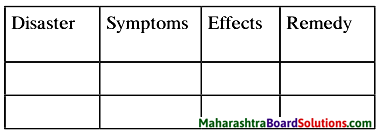
Answer:
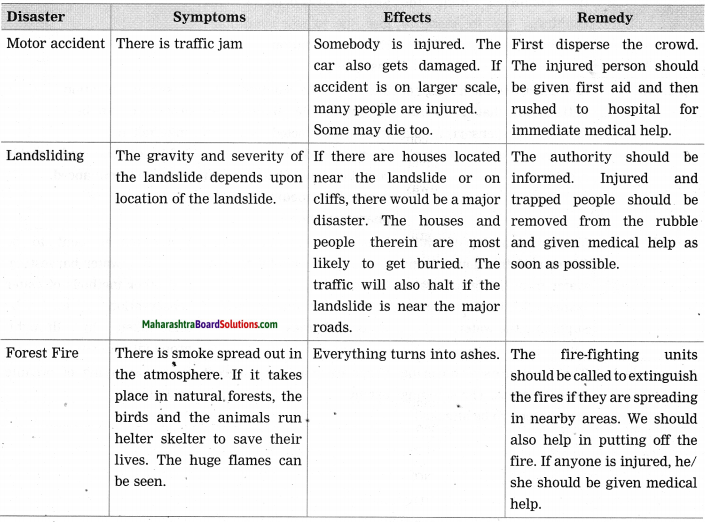
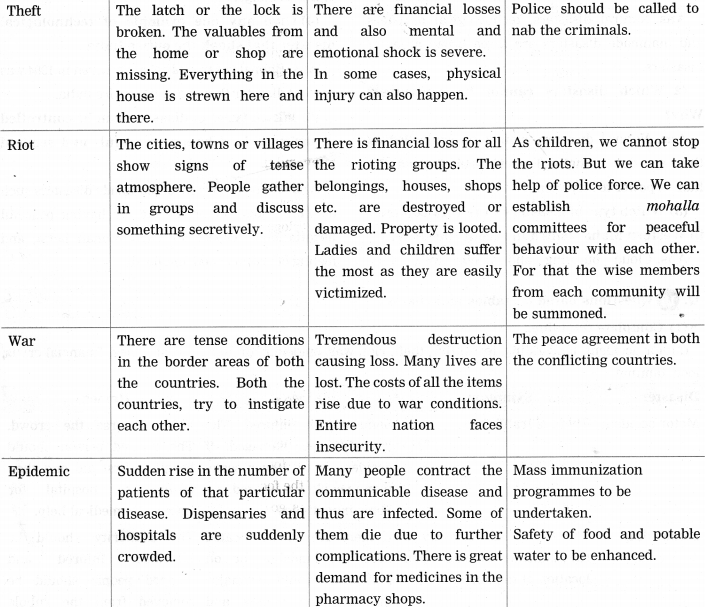

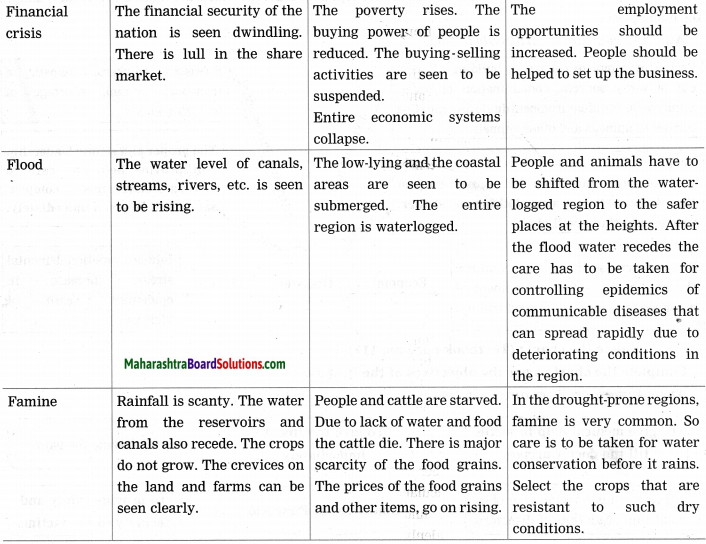
![]()
Question 2.
Write notes.
a. Disaster Management Authority.
Answer:
Disaster Management Authority is the body that works at the level of government from national level to village level. This work is basically about management of any disaster and tackling the problems of the affected people. At National level there is National Disaster Management Authority for which the Prime Minister is the chairman. For every state there is State Disaster Management Authority, where the chief minister of every state is the chairman. Under the state level, there are district level units where district collector is responsible for disaster management and implementation of rehabilitation schemes. Below district level authority there are Taluka and then Village Disaster Management Committees.
The Tahsildar is the chairman for Taluka level while the Sarpanch of the village is responsible for management of disasters at village level. Collector of each district helps in planning, coordinating and controlling the implementation of rehabilitation programme and also gives essential instructions and reviews the entire system.
b. Nature of disaster management.
Answer:
Disaster management involves either prevention of disasters (Pre-disaster management) or creating preparedness to face them (Post-disaster management). The action plans are prepared for managing disasters. This is done after studying the different aspects such as preventive measures, rehabilitation and reconstruction plans. The disasters are tackled by executing action plans in the following steps: Preparation, redemption, preparedness, action during actual disaster, response, resurgence and restoration. At every level there are other voluntary organizations and Government meteorological institutions for their help.
c. Mock drill.
Answer:
- Mock drill is the practice to check whether there is preparedness for dealing with the sudden attack of disaster.
- For this purpose, virtual or apparent situations that simulate the disaster are created.
- The reaction time for any type of disaster is checked by such activity. In the presence of trained personnel, the execution of the rescue plans are observed.
- People also understand their responsibilities at the time of actual disaster.
- The experts also check execution of plan designed for disaster redressal.
- By such mock drills, the efficacy of the system can be understood. In future, when actual calamity strikes, there is already preparation for disaster redressal. Therefore, mock drill is useful.
d. Disaster Management Act, 2005.
Answer:
Government of India has made Disaster Management Act in 2005. The affected people are given all necessary help as per this act. With the humanitarian view, people are rehabilitated and helped them to come back to normalcy after the disaster.
As per this Act, National Disaster Response Force has been established. This force consists of 12 divisions in entire India which are attached with Indian Army. The headquarter is located in Delhi, but the action is taken all over the country with the help of army. As per the Act, in Maharashtra National Disaster Response Force is in action through State Reserve Polioe Force. The personnel of this force are trained accordingly, and they take part in the rescue work during different disasters.
Question 3.
Answer the following questions.
a. Explain the role of district disaster control unit after occurrence of any disaster.
Answer:
(1) District control unit looks after the ; disaster management of the district.
(2) It is immediately formed either after the impact of disaster or if warning is given about some upcoming disaster.
District-wise Disaster Control Unit performs following role:
- The review of various aspects of disasters is done.
- Through the disaster control unit there is continuous contact established with various agencies like army, air force, navy, telecommunication department, paramilitary forces, etc. for obtaining help.
- The unit also coordinates with various voluntary organizations for their help in disaster management.
b. Give the reasons for increase in human disasters after the World War-II.
Answer:
- After Second World War, the feelings of peace and brotherhood among the global citizens were lost. The geographic, religious, racial and ethnic differences sprang up tremendously.
- Atrocities that Nazi has performed made deep impact on the minds of people. Terrorism, abduction, robberies and social unrest increased in almost all the countries.
- The financial losses had incurred in the World War II. The misuse of science and technology was done to retrieve these deficits.
- At the end of World War II, the atomic bombs were dropped in Japan. This has created health problems in the entire world.
- Social inequality, economic disparity, racial and religious differences were some adversaries that created unrest in the country.
- Later, the neighbouring nations kept on fighting. The geographical boundaries were changed. People always had feelings of insecurity. The terrorism flourished. All such instances gave rise to man-made disasters.
c. What are the objectives of disaster management?
(OR)
State any four objectives of disaster management. (March ’19)
Answer:
Objectives of disaster management:
- To save human life from disasters. To help them for moving away from the place of disasters by rapid action.
- To supply essential commodities to the affected people. This helps to reduce the gravity of disaster. People are given grains, water and clothes and other basic necessities under this objective.
- To bring back the conditions of affected people to normalcy.
- To rehabilitate the affected and displaced victims.
- To think and execute the protective measures in order to develop capability to face the disasters in future.
d. Why is it essential to get the training of first aid? (July ’19)
Answer:
When there is a disaster, we need to immediately help the victim. Till the medical help arrives, one should be in position to treat the injured and save his or her life. In such cases; knowing first- aid is essential. Such kind of a need may arise in case of our parents, our siblings at home or with friends in school. Those who are injured should be treated at once. If we know about techniques of first aid, we can save such person before the medical help arrives. Therefore, it is essential to get the training of the first aid.
e. Which different methods are used for transportation of patients? Why?
Answer:
For the transportation of patients following methods are used:
- Cradle method: This method is used for children and persons with less weight.
- Carrying piggy back: This method is useful in carrying the unconscious persons.
- Human crutch method: If one leg of the person is injured, then the victim is supported with minimum load on the other leg. This is called human crutch method.
- Pulling or lifting method: For carrying an unconscious person for a short distance this method is used.
- Carrying on four-hand chair: This method is used when the support is needed for a part below waist region.
- Carrying on two-hand chair: Patients that cannot use their hands but can hold their body upright, are carried by such method.
- Stretcher: By making temporary stretcher in case of emergency, the unconscious patient can be moved. Such temporary stretchers are made by using bamboos, blanket, etc.
![]()
Question 4.
On the basis of the structure of disaster management authority, form the same for your school.
Answer:
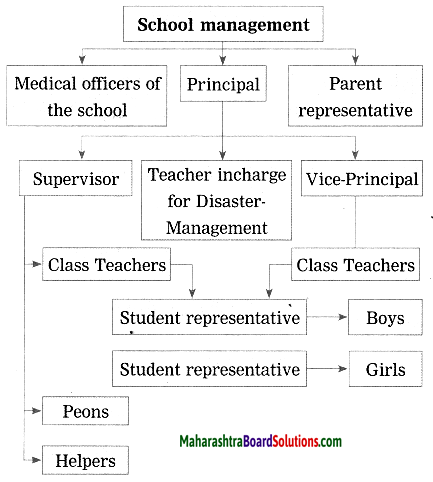
Question 5.
Write down the reasons, effects and remedial measures taken for any two disasters experienced by you.
Answer:
Students are expected to write the answer based on their own experiences.
Question 6.
Which different aspects of disaster management would you check for your school? Why?
Answer:
For the pre-disaster management at school following aspects would be inspected.
- Are the telephones 6f the school working properly?
- Is there a first-aid box in each class?
- Are there any basic medicines in the school?
- Is the team ready for rescue of smaller children from lower classes?
- Has monitor or prefect participated in a mock drill? Does he/she know about first aid?
- Is the contact of parent representative available in emergency situations?
- Is the Medical Officer/Doctor present on the school campus?
- Is there enough drinking water and some dry snacks available in the school?
- Are the staircases and corridors suitable for quick evacuation of the children?
![]()
Question 7.
Identify the type of disaster.
a. Terrorism.
Answer:
Man-made, intentional.
Due to the activities of terrorism, many innocent lives are lost. Many are seriously injured. Some become crippled for their entire life. Buildings, monuments, vehicles everything is completely destroyed. There is rift between different religions or sects. The peaceful atmosphere is disturbed. The entire society is under the constant fear of insecurity.
b. Soil erosion.
Answer:
Natural, geophysical, geological.
When the upper fertile layer of soil is lost, it becomes barren. The trees are uprooted. The fertility of the area is lost. The land becomes unsuitable for cultivation or farming. Due to wind, flowing water or grazing animals the naturally occurring soil erosion becomes hazardous for the environment.
c. Hepatitis.
Answer:
Natural, biological, animal-origin.
Hepatitis is a viral disease which spreads through the contaminated food and water. The outburst of epidemic of hepatitis is difficult to control. As in big cities the quality of road side food is often consumed, the spread of hepatitis is. fast. People suffer due to hepatitis.
d. Forest fire.
Answer:
Natural, biological, plant-origin.
Due to heat and wind, the dry grass and the shrubs catch fire in the forests, resulting in forest fires. Such rapidly spreading forest fire can finish the biodiversity within a very short span of time. It is difficult to extinguish the naturally lit forest fires. Many trees and other vegetation, animals and birds along with their habitats are destroyed due to forest fire. The smoke emanating causes the air pollution.
e. Famine.
Answer:
Natural, climatic.
Due to famine there is severe water scarcity. In absence of water, the fields and farms become barren as the crops cannot grow without water. There is shortage of food grains. The cattle dies due to want of water and grass. Local people have to migrate in search of food, water and shelter.
f. Theft.
Answer:
Man-made, intentional.
Theft causes economic loss for the one whose money or valuables are looted. The person who suffers the loss also undergo mental and emotional shock. Sometimes the thief may also cause physical harm. It may cost on life too.
Question 8.
Some symbols are given below. Explain those symbols. Which disasters may occur if those symbols are ignored?
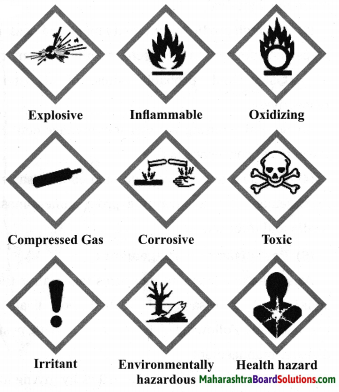
Answer:
The above signs are warning symbols which should never be ignored.
The meaning of each is given below. They are giving warnings about explosive, inflammable, oxidizing, compressed gas, corrosive, toxic, irritant, environmentally hazardous and health hazard.
(1) Explosive: Some materials are explosive. While handling such materials care should be taken. We should not take anything that would cause fire leading to explosion. If explosion occurs, there would be a major disaster causing great loss of life and property. Thus if this sign is seen, great care has to be taken.
(2) Inflammable: Similar to explosive substances, the inflammable materials can also catch fire easily. Therefore, to warn people such sign is given on materials that can cause hazard by burning.
(3) Oxidizing: Some chemical substances are oxidizing. They carry out chemical reactions with a rapid speed. E.g. If potassium permanganate falls on the cloth, it starts the reaction on its C-C bonds. Due to such property of carrying out reactions, the cloths may catch fire. Therefore, oxidizing substances should be handled with care.
(4) Compressed: Compressed substances are filled under pressure in some container. If mishandled, they can come out of the container by bursting it open. This can cause some injuries.
(5) Corrosive: The corrosive substances are very reactive. The mere touch of corrosive substances can cause destruction of skin, eyes, respiratory passages, digestive organs, etc. rapidly. Just touching or smelling of such substances can cause major injury and thus warning sign of corrosive substance should never be ignored.
(6) Toxic: To taste a toxic substance or even to smell it, can lead to death. The packing of these substances are therefore marked as dangerous. They should be avoided as far as possible.
(7) Irritant: When skin or any delicate part of the body comes in contact with the irritant substance, it can cause harmful reaction. Especially, eyes, nasal mucosa and skin are affected by contact with corrosive substances.
(8) Environmentally hazardous: Many sub¬stances cause harm to the environment due to their toxicity. Air, water or soil can be polluted due to such pollutants. When environment is affected, ultimately these hazardous effects come back to human species. Therefore, such substances should be carefully used. Their use should be judicious and controlled.
(9) Health hazard: The substances that can cause hazard to our health should always be distanced from us. Such substances should not be kept in proximity. As far as possible they should be kept away and handled with great care if needed for any work. Materials marked with health hazard can cause severe toxicity.
![]()
Question 9.
Explain that why is it said like that?
a. Mock drill is useful.
Answer:
- Mock drill is the practice to check whether there is preparedness for dealing with the sudden attack of disaster.
- For this purpose, virtual or apparent situations that simulate the disaster are created.
- The reaction time for any type of disaster is checked by such activity. In the presence of trained personnel, the execution of the rescue plans are observed.
- People also understand their responsibilities at the time of actual disaster.
- The experts also check execution of plan designed for disaster redressal.
- By such mock drills, the efficacy of the system can be understood. In future, when actual calamity strikes, there is already preparation for disaster redressal. Therefore, mock drill is useful.
b. Effective disaster management makes us well prepared for future.
Answer:
- Disaster can strike any time. The sudden disasters can be man-made with some bad intentions or may be accidental.
- When natural calamity strikes suddenly with a huge impact, large scale devastation of property and general environment degradation occurs along with substantial mortality of people and animals.
- Therefore, it is most appropriate to have the preparedness to reduce the impact of any future disasters.
- We cannot control the onset of the natural disaster, but we can definitely reduce the harsh effects of the disaster by following disaster management plan.
Question 10.
Complete the following chart.
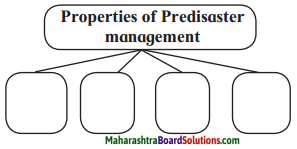
Answer:
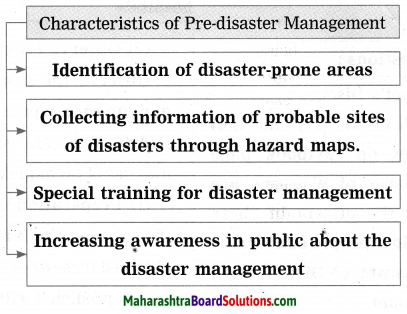
Question 11.
Following are the pictures of some disasters. How will be your pre and post-disaster management in case you face any of those disasters?

Answer:
In the pictures given, following disasters are shown:
(1) Two groups of children are fighting with each other.
(2) There is gas leakage from the LPG cylinder.
(3) There is heavy downpour due to cloud bursting which has led to waterlogging in the town.
(4) There is cyclone causing a tornado. (Commonly called a twister)

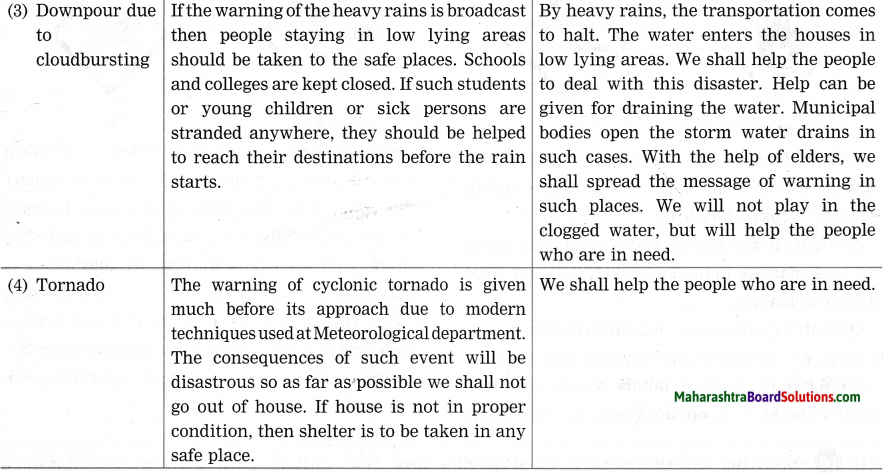
Projects:
Project 1.
Demonstrate the activities shown on page no. 106 of Std. IX Science and Technology textbook in front of the students of other classes. Make a video clip and send it to others.
Project 2.
Form a group of students from your school to demonstrate the mock drill and demonstrate it in the school
![]()
Can you recall? (Text Book Page No. 109)
Question 1.
What is disaster?
Answer:
Disaster is the incidence that occurs suddenly causing heavy damage to life and property. The disaster can be man-made or due to natural reason.
Question 2.
Which disasters have you experienced in your area?
Answer:
On September 2019, there was a heavy downpour in Pune. This disaster has been experienced recently.
On 26th November 2008 there was attack at several places by the Pakistani terrorists. The stories about the deaths and damage caused by this disaster were seen in films and learnt about this from our elders.
Question 3.
What are the effects of that disaster on local and surrounding conditions?
Answer:
Due to a heavy downpour in Pune, there was waterlogging in all the shallow areas. All the transport systems collapsed on that day. Large trees fell down injuring the people. The water logging caused condition like floods. Schools, colleges and offices were shut down. People were caught in troublesome situation.
On 26th November 2008 many innocent people lost their lives. There was tremendous damage caused to some of the important places like Taj Palace Hotel and Chabad house.
Use your brain power: (Text Book Page No. 111)
Question 1.
Depending upon information given on page 111, explain the various effects of the disaster of railway accident.
Answer:
The effects of disastrous railway accident:
The effect will be dependent upon the nature of the accident that has occurred. Whether, it is a collapse of bridge or due to derailment of the train, or due to collision of two moving trains, whether it is due to failure in signaling system, due to land slide or due to obstacle in the tunnel, that has to be understood. The impact of such railway accident will be dependent on the way that accident has occurred. Based on this impact the effects will take place.
| (1) Environmental | The entire surroundings will show destruction. |
| (2) Administrative/ Managerial | The railway department will have stress and the time table will collapse. The regular use of tracks will hamper, resulting into delay in railway traffic. |
| (3) Political | Ministry of railways is considered to be responsible for the accident. Sometimes the Railway Minister resigns. |
| (4) Medical | The passengers commuting in the train die or suffer from serious injuries. |
| (5) Economic | The railways suffer huge financial loss. |
| (6) Social | The railway traffic is disturbed. Passengers are troubled as they get held up at some place. |
Observe/Discuss:
Let’s Discuss: (Text Book Page No. 110)
Question 1.
observe the images on textbook page no. 110. whether the places of disasters are known to you? Discuss the emfects of these disasters on public lire. How people could lave been saved from these disasters? Discuss with your friends in the classroom.
Answer:
Students should discuss the disasters given in the pictures by themselves after collecting the information.
![]()
Observe: (Text Book Page No. 114)
Question 1.
Observe the disaster cycle given below and explain each aspect of the disaster of earthquake.
Answer:
The main aspects of disaster cycle to tackle disaster of earthquake are as follows:
(1) Preparation : With the help of seismograph, the warning about forthcoming earthquake can be obtained these days. The intensity of the earthquake is also predicted with the help of technology. If the estimate of the Richter scale is on the higher sides, there would be more preparatory measures taken to tackle the forthcoming problem of earthquake.
(2) Redemption: Once this information is obtained the possible impact of the earthquake on the houses, buildings, people can be studied by the geological experts. The meetings of the Disaster Management Authority will be organized for same.
(3) Preparedness: What the general public should do and what action the reserved forces should take, will be decided in case of actual incidence of the earthquake. The schemes and plans will be made ready in this direction.
(4) Impact of Earthquake: In case of disaster of earthquake, people will be helped to safety. The trapped people will be rescued. First aid and other necessary help will be provided. The data about the losses and the intensity of this disaster will be noted and reported for the further process.
(5) Response: In this phase the response of the people as well as the action of Government can be well studied. The response should be quick and positive. The maximum lives and property should be saved by such responses. The disaster of earthquake should be managed with positivity and through help given to the sufferers.
(6) Resurgence: Earthquakes can destroy the entire households or even entire community. Such homeless people should be given the place to stay. Resurgence is important phase for the national welfare. If the citizens of India are cared for, the nation too will progress.
(7) Restoration: The earthquake victims should be settled by providing them with new settlements. Sometimes, entire village is to be settled. E.g. In Latur or Kutch, there twas very large scale devastation. But Government of India as well as some NGOs helped to reconstruct the houses. In such earthquake-prone areas, houses are built in specific pattern to withstand any possible future calamities.
Observe: (Text Book Page No. 117)
Question 1.
Give the reference of following pictures and explain importance of each of those in disaster management. Which are other such activities ?
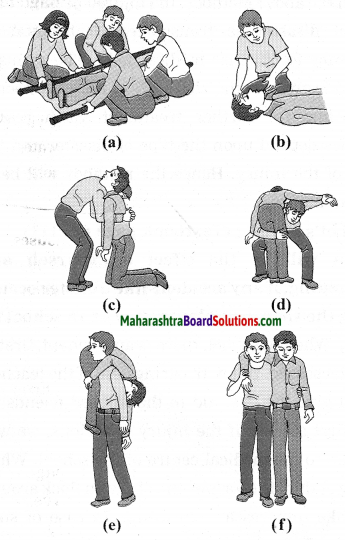
Answer:
The actions shown in the above pictures are as follows:
(a) The patient is made to lie on the stretcher. He must be unconscious and injured to greater extent, so that he cannot move by himself.
(b) The patient is helped by giving artificial respiration. Probably the victim is suffocated and needs oxygen supply.
(c) and (d) The patient is being picked up. Most probably the patient is unconscious.
The unconscious person who cannot move by himself is carried by these two methods. In method ‘c’, the weight of the patient is less and hence he can be lifted as shown in the picture. In picture ‘d’ the victim has to be lifted in other way, may be due to his greater body weight.
(e) The patient is carried on the back as in ‘carrying piggy back’ position. He too is unconscious and needs to be shifted for medical treatment.
(f) The patient in this picture is carried by ‘human crutch method’. When victim’s one leg is injured, he cannot walk without support. Hence, he needs to be carried in such a way.
In all the above methods, the injured person at the time of disaster is transported to hospital or dispensary for further medical help. The primary first-aid is given to the victim. Now the volunteer is taking him for further treatment. Such rescue activities depend upon the type of disaster and the extent of the injury. Hence the methods will be of different nature.
![]()
Let’s Think: (Text Book Page No. 111)
Question 1.
What will be the effect on yourself and surrounding, if any accident-like disaster occurs during the sports on playground or in school?
Answer:
When in school, there is an accident, first of all we get scared. But with caring help of the teacher, we will give the first aid to the injured friends by using first aid kit. If the injury is serious, we will take him to the medical centre of the school. While playing or during sports event, children flock around and make unnecessary crowding. In case of such accident, first of all the crowd will have to be dispersed. If there is major disaster, one should not fumble but manage the disaster in a wise way with the help of teachers.
Let’s Think: (Text Book Page No. 112)
Question 1.
Explain the nature and scope of the disaster of flood with the help of six points given on text book page no. 112.
Answer:
The nature and the scope of the disaster of flood can be described according to the six points:
(1) Pre-disaster phase: Due to Indian Meteorological Department the warning predictions are received before any climatic disaster strikes. If the scope of the flood is predicted to be high, then the people who may be affected by the calamity are relocated to a safer area.
(2) Warning phase: In the warning phase the Government warns the general public about the forthcoming disaster of floods through mass media like radio, television, newspapers, etc. In recent times, even the cellphone messages are sent to people for warning them. The people living in coastal areas will be worst affected and hence such people are given greater care and they are immediately made to leave their houses. They are taken to the safe places.
(3) Emergency phase: When the flood waters actually start rising up, the low-lying areas are submerged. Houses, roads and shops everything goes under water. The rescue operations are carried out by army men from National Disaster Rescue Force. They take every possible effort to rescue the trapped people. The emergency continues till the water does not recede. Later after the water starts receding, people who had been taken to places on heights, start coming back. During this phase, search, rescue operations, medical treatment, and first aid are all the aspects on which the attention is focussed.
(4) Rehabilitation phase: The people affected due to floods are given emotional and financial support. The fields, farms, houses or cattle-shed are under water. Such people are given transient accommodations. Many cattle and other animals die by drowning. Their rotting carcasses have to be disposed as soon as possible because the decaying process spreads epidemics of diseases. People are given vaccinations to protect them from diseases of such kind. Special care of young children and senior citizens is taken during this period. Supply of food and drinking water is also very important task during this time.
(5) Recovery phase: During recovery phase, the life comes gradually back to normalcy. The removal of dead, decaying material and the debris is the first priority. The water connections and electricity is restored back. Various NGOs or Government organizations provide help of various kind to the affected people. This help is to be distributed to those who are in real need. This work is also done by Disaster Management Department.
(6) Reconstruction phase: The houses and building that collapse due to floods are built back. Agricultural activities start again. Roads and water supply is once again normalized. Schools and colleges start once again. Thus, the once flood affected area comes back to routine functioning again.
Let’s Think: (Text Book Page No. 117)
Question 1.
Following are some pictures of disasters. Which precautions would you take during those disasters?

Answer:
The pictures shown above are showing earthquake, fire and snake bite respectively.
In the above disasters, the initial precautions to be taken are as follows:
(1) Earthquake: In case of earthquake, one should immediately come out of house and stand in the open ground. If this is not possible, one has to go below table or any other cover. During collapse of the building, there should not be a head injury. This precaution is basically for prevention of dangerous injuries and saving our life. Switch off the power supply. If in journey, stay inside the vehicle.
(2) Fire: First and foremost is to save ourselves from fire. Then one can help others in rescue operations. Help others to extinguish fire. Call the fire department for immediate action.
(3) Snake bite: Many a times the biting snake can be non-venomous too. But the victim is psychologically affected too. The tourniquet should be tied in the region above the snake bite. The rope, piece of cloth or even handkerchief can be used for this purpose, so that the venom, if any should not rise and reach vital organs. The wound should be made near the bite-wound so that the blood will ooze out and some venom can automatically flow out. Though these are first-aid measures, the victim should be rushed to a qualified doctor for an injection of antivenin.
Choose the correct alternative and write its alphabet against the sub-question number:
Question 1.
Disasters definitely affect the ………… of the nation.
(a) people
(b) economy
(c) security
(d) employment
Answer:
(b) economy
Question 2.
If local ………… is not strong enough, citizens become confused.
(a) leadership
(b) women
(c) politicians
(d) cattle
Answer:
(a) leadership
Question 3.
…………… problems arise diming the disaster.
(a) Local
(b) Global
(c) Administrative
(d) Private
Answer:
(c) Administrative
Question 4.
Stinking pollution caused due to decomposing corpses of humans and other animal is ………… disaster.
(a) environmental
(b) health
(c) necessary
(d) effective
Answer:
(a) environmental
![]()
Question 5.
After the subsidence of any type of disaster, rehabilitation work is started in ………… phase.
(a) later
(b) transitional
(c) terminal
(d) ultimate
Answer:
(b) transitional
Question 6.
…………. phase is highly complicated phase.
(a) Reconstruction
(b) Recycling
(c) Reuse
(d) Redevelopment
Answer:
(a) Reconstruction
Question 7.
There had been a huge ……….. in the village Malin, Tal. Ambegaon in 2014.
(a) earthquake
(b) storm
(c) landslide
(d) change
Answer:
(c) landslide
Question 8.
The atomic energy plant at Chernobyl was used only for generating ………….
(a) electricity
(b) solar power
(c) atomic energy
(d) agriculture
Answer:
(a) electricity
Question 9.
Supply of essential ………….. to the affected people can reduce the effect of the disaster.
(a) food
(b) water
(c) commodities
(d) money
Answer:
(c) commodities
Question 10.
Keeping …………. ready is a practice to check the preparedness of facing the disaster.
(a) First aid
(b) Mock drill
(c) Ambulance
(d) Fire brigade
Answer:
(b) Mock drill
Question 11.
Which of the following is man-made disaster. (March, July ’19)
(a) Earthquake
(b) Flood
(c) Meteor
(d) Leakage of toxic gases
Answer:
(d) Leakage of toxic gases
Question 12.
What should be done if gas cylinder at your house catches fire?
(a) Water should be sprinkled
(b) Sand, soil should be put on it
(c) Cylinder should be covered with wet blanket
(d) one should run away
Answer:
(c) Cylinder should be covered with wet blanket
Which type of disaster is described in the following statements:
Question 1.
On 26th July 2005, entire suburban Mumbai was waterlogged.
Answer:
Cloudbursting and severe downpour
Question 2.
Elephants in the Bandipur forest started running helter and skelter due to smoke.
Answer:
Forest fires
Question 3.
Many innocent people died in the bomb blast that occurred on 11th July 2006 in local trains.
Answer:
Bomb explosion-Terrorism
Question 4.
In Kutch, suddenly many school children were buried under the rubble.
Answer:
Earthquake
![]()
Question 5.
Because of lack of crops, people from Vidarbha are migrating to other regions.
Answer:
Dry famine
Question 6.
The huge waves in Chennai engulfed many human lives in December 2004.
Answer:
Tsunami.
Find the correlation:
Question 1.
Earthquake in recent times : Gujarat, Latur : : Devastating floods in 2018 : ………….
Answer:
Earthquake in recent times : Gujarat, Latur : : Devastating floods in 2018 : Kerala/Assam
Question 2.
Toxic gas leakage: Accidental disaster : : war : …………..
Answer:
Toxic gas leakage: Accidental disaster : : war : Intentional
Question 3.
Sun spots : Atmospheric type of disaster : : Salinization : …………..
Answer:
Sun spots : Atmospheric type of disaster : : Salinization : Geological type of disaster
Question 4.
Pre-disaster management : Preparation and warning : : Post-disaster management : ………..
Answer:
Pre-disaster management : Preparation and warning : : Post-disaster management : Resurgence and restoration.
Match the columns:
Question 1.
| Column A: Disaster | Column B: Type |
| (1) Earthquake and volcano | (a) Animal origin |
| (2) Snowfall and snowstorms | (b) Geological |
| (c) Climatic | |
| (d) Terrorism |
Answer:
(1) Earthquake and volcano – Geological.
(2) Snowfall and snowstorms – Climatic.
![]()
Question 2.
| Column A: Disaster | Column B: Type |
| (1) Aquatic weeds | (a) Animal origin |
| (2) Attack by locusts (insects) | (b) Plant origin |
| (c) Geological | |
| (d) Climatic |
Answer:
(1) Aquatic weeds – Plant origin
(2) Attack by locusts (insects) – Animal origin.
Question 3.
| Column A: Disaster | Column B: Type |
| (1) Atomic tests | (a) Intentional |
| (2) Terrorism | (b) Unintentional |
| (c) Geological | |
| (d) Animal origin |
Answer:
(1) Atomic tests – Unintentional
(2) Terrorism – Intentional.
Question 4.
| Column A: Effect | Column B: Effect |
| (1) Contamination of water | (a) Economical |
| (2) Collapsing of transport system | (b) Environmental |
| (c) Administrative | |
| (d) Geological |
Answer:
(1) Contamination of water – Environmental
(2) Collapsing of transport system – Administrative.
Question 5.
| Column A: Effect | Column B: Problem |
| (1) Spread of epidemics | (a) Economical |
| (2) Shortage of funds | (b) Administrative |
| (c) Medical | |
| (d) Physical |
Answer:
(1) Spread of epidemics – Medical
(2) Shortage of funds – Economical.
Question 6.
| Column A: Effect | Column B: Problem |
| (1) Rift due to religions | (a) Economical |
| (2) Citizens getting confused | (b) Social |
| (c) Political | |
| (d) Environmental |
Answer:
(1) Rift due to religions – Social
(2) Citizens getting confused – Political.
Identify the type of disaster and describe the effects of the same in brief:
Question 1.
Accident at Chernobyl.
Answer:
Man-made, unintentional. At Chernobyl in Russia there was the atomic energy plant, where disastrous accident took place. The radiations emitted through the reactors caused tremendous radiation pollution. These hazardous effects are even seen today.
Give reasons:
Question 1.
When there are riots, the cities, towns or villages show signs of tense atmosphere.
Answer:
- During riots, there is financial loss for all the rioting groups.
- The belongings, houses, shops, etc. are destroyed or damaged.
- Property is looted. There is no guarantee of safety and security for anyone.
- Women and children suffer the most as they are easily victimized. Therefore, when there are riots, the cities, towns or villages show signs of tense atmosphere.
Answer the following questions in detail:
Question 1.
which are the disaters that make Impact for longer duration? Give examples.
Answer:
Those disasters that make the impact for long duration and those disasters, whose after-elfbcts are either severe are long term disasters. Their severity increases with thme. Such disasters are famine, various problems of growth of crop, strikes of workers, rising levels of oceans, desertification, etc.
Question 2.
What types of disaster are the following? Explain their impacts.
(a) Floods (b) War. (Board’s Model Activity Sheet)
Answer:
(a) Flood is geophysical climatic disaster.
(b) War is man-made intentional disaster.
Impact of flood : The low-lying and the coastal areas are seen to be submerged. The entire region is waterlogged.
Impact of war: Tremendous destruction causing loss. Many lives are lost. The costs of all the items rise due to war conditions. Entire nation faces insecurity.
![]()
Question 3.
Explain in brief the sensitive issues of general public about disaster.
(OR)
Which are the three aspects of disaster tjiat are important for common citizens?
Answer:
The phase of emergency, transitional phase and reconstruction phase are the three phases of disaster that are important for common citizens.
(1) Phase of emergency: If timely and rapid action is taken during this phase, maximum lives can be saved. Search and rescue operations, medical help, first aid, restoring communication services, removing the people from affected area are done during this phase. The gravity of disaster can be estimated during this phase.
(2) Transitional Phase: The disaster subsides and then the work of transitional phase starts. The main concern is rehabilitation work for the affected and displaced people. This work includes clearing of debris, restoring water supply, repairing roads, etc. to bring normalcy in public life. Help from different voluntary and Government institute is taken to offer the monetary provision and essential commodities to affected victims. Permanent means of livelihood is given to the people to reduce their mental and emotional stress. The victims are truly rehabilitated.
(3) Reconstruction Phase: Reconstruction phase is a highly complicated phase which actually overlaps with transition stage. Help is offered to people to reconstruct their buildings. Other facilities like roads and water supply are restored. Farming practices are restarted. It is a very gradual phase that makes the victims to completely rehabilitate.
Question 4.
What are the objectives of mock drill?
Answer:
Objectives of Mock Drill:
- To evaluate the response of the people to the disaster.
- To improve the coordination between various departments of disaster control.
- To identify one’s own abilities if disaster approaches.
- To improve the ability to quick response to disaster and taking rapid action.
- To check the competency of the planned actions.
- To identify the possible errors and risks while dealing with disasters.
Question 5.
Write down the names of international organizations that work for disaster management.
Answer:
Following international organizations work for disaster management.
- United Nations Disaster Relief Organization
- United Nations Centre for Human Settlements
- Asian Disaster Reduction Centre.
- Asian Disaster Preparedness Centre.
- World Health Organization.
- United Nations Educational, Scientific and Cultural Organization.
Question 6.
The building in which you are residing ( has caught fire on the ground floor. What necessary rescue steps will you take? (July ’19)
Answer:
- We shall call out for help.
- We shall immediately call fire brigade.
- We shall try to extinguish fire with the help of other people.
- We will give first aid to people who are injured, fill the medical help arrives.
- We will cover our nose and mouth with moist cloth to prevent suffocation.
Write short notes:
Question 1.
Pre-disaster management.
Answer:
The management measures taken before onset of a disaster is called pre-disaster management.
In pre-disaster management, complete preparation and planning to face any type of disaster is done. For this purpose, following steps are taken.
- Identifying the areas where the disaster can strike. Such disaster-prone areas are to be thoroughly studied.
- Through predictive intensity maps and hazard maps, the information is collected about the intensity of disaster and probable sites of disasters respectively.
- Special training for disaster management is given to the concerned people.
- The mass awareness is created about disaster management through training programmes, mass media and internet, etc.
![]()
Question 2.
Post-disaster management.
Answer:
The management measures taken after the striking of a disaster is called post-disaster management.
Following steps are taken during post-disaster management:
- Helping the victims of disasters by giving all possible help needed for their survival.
- Local people are trained to take part in the disaster management so that affected people can be saved rapidly.
- Establishing the help centres that could provide all the necessary help. Such centres will be different in case of different disasters.
- Collection and categorization of the material received from control centre for helping the victims. Distributing the same and reviewing the measures continuously.
- Disaster rescue programmes are mainly focused.
Some symbols are given below. Explain those symbols. Which disasters may occur if those symbols are ignored?
Question 1.
Write what the signs indicate:
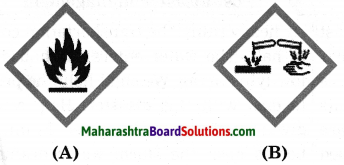
Answer:
- Figure A indicates inflammable substances. They can catch fire if they come in contact with oxygen-rich air.
- Figure B indicates corrosive substances which can cause damage to tissues of skin, eyes and other delicate organs etc.
- Both the symbols are warning signs for people to keep away or handle carefully such substances.
![]()
Question 2.
What does the symbols below indicate? Write in brief. (Board’s Model Activity Sheet)
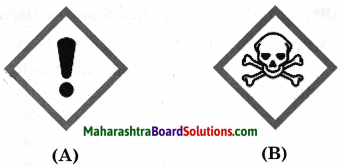
Answer:
(1) Symbol ‘A’ indicates Irritant. When skin or any delicate part of the body comes in contact with the irritant substance, it can cause harmful reaction. Especially, eyes, nasal mucosa and skin are affected by contact with corrosive substances.
(2) Symbol ‘B’ indicates toxic substance. To taste a toxic substance or even to smell it, can lead to death. The packing of these substances are therefore marked as dangerous. They should be avoided as far as possible.
Complete the paragraph by choosing the appropriate words given in the brackets:
(Capability, Rehabilitation, Commodities, Human, objectives, normalcy, amusements)
The ………. of disaster management comprise of the following aspects …………. life is saved from the disasters. People are helped to move away from the place of disasters. They are given essential ……….. by the government so that the gravity of disaster is reduced. The disaster conditions are brought back to ………… of the affected and displaced victims is done. Moreover, protective measures for future are also planned to develop ………… among the people to face any possible disasters in future.
Answer:
The objectives of disaster management, comprise of the following aspects. Human life is saved from the disasters. People are helped to move away from the place of disasters. They are given essential commodities by the government so that the gravity of disaster is reduced. The disaster conditions are brought back to normalcy. Rehabilitation of the affected and displaced victims is done. Moreover, protective measures for future are also planned to develop capability among the people to face any possible disasters in future.
Paragraph based questions:
1. Read the paragraph and answer the questions given below:
Disasters can be properly classified into three categories, viz. natural disasters, technological disasters and man-made disasters. The forces that cause natural disasters cannot be controlled. Moreover, they are becoming more frequent in the current years due to phenomena of climate change. On and off incidences of cyclones, cloud bursting, floods, etc. am creating havoc in the lives of people. Technological disasters are due to improper and callous behaviour at the different processes carried out in technical establishments. Man-made disasters are conflicts arising due to different religions, regions and-terrorism.
Questions and Answers:
Question 1.
What are three broad areas of disasters?
Answer:
Natural disasters, technological disasters and manmade disasters are three broad areas of disasters.
Question 2.
Which disasters cannot be controlled? Why?
Answer:
Natural disasters cannot be controlled as they are due to natural phenomena beyond the human power to stop them.
Question 3.
Which type of disasters were very common in Western Maharashtra in recent times? Why?
Answer:
Cloud bursting and floods were very common in Western Maharashtra caused due to climate change.
Question 4.
Give any one example of technological disaster that shook the entire India.
Answer:
Bhopal gas tragedy that occurred in 1984 was a worst disaster that shook the entire India.
Question 5.
Which types of disasters can be controlled in order to lead happy, peaceful and secured life? How?
Answer:
We have to control manmade disasters such as wars, riots, terrorism, etc. by having peaceful negotiations, respect for each human being and feeling of brotherhood among all.
![]()
Questions based on tables and charts:
Question 1.
Complete the chart: (Text Book Page No. 111)
Different problems occur with disasters. In the concept map different effects are mentioned. Read it and fill the blank places.
Answer:
(Answers are given directly in bold.)
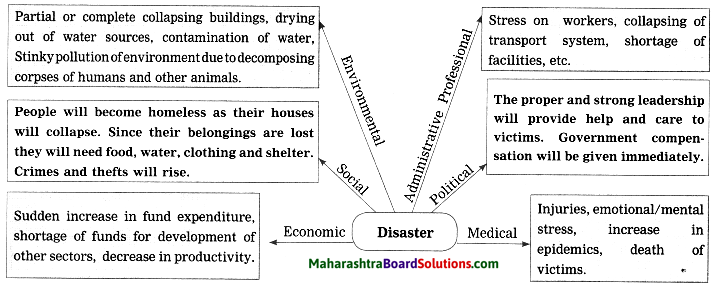
Question 2.
Complete the chart: (Text Book Page No. 117)
Complete the chart as per the objectives of the first aidr:t
Answer:
(Answers are given directly in bold.)

Activity based questions:
Question 1.
Observe the images ‘A’ and ‘B’ and answer the following questions.

(i) Which disasters are shown in the images ?
Answer:
Image A is showing damage due to earthquake. Image B is showing house on fire.
(ii) Which primary precautions will you take in case of disaster shown in ‘A’?
Answer:
In the above disasters, the initial precautions to be taken are as follows :
Earthquake: In case of earthquake, one should immediately come out of house and stand in the open ground. If this is not possible, one has to go below table or any other cover. During collapse of the building, there should not be a head injury. This precaution is basically for prevention of dangerous injuries and saving our life. Switch off the power supply. If in journey, stay inside the vehicle.
(iii) Which type of first-aid is offered to the injured people in disaster ‘B’?
Answer:
First aid given to burn victim:
- The person who is injured by fire should be dotised with cold water on his/her body. This will extinguish fire and give some relief caused due to inflammation. Do not break the blisters. Give water to drink.
- Cover the burnt part by wet and moist cloth. Wash the wounds with antiseptic solution.
- If the person is severely burnt, transfer him/her immediately to hospital.
Question 2.
Correct the following diagram:
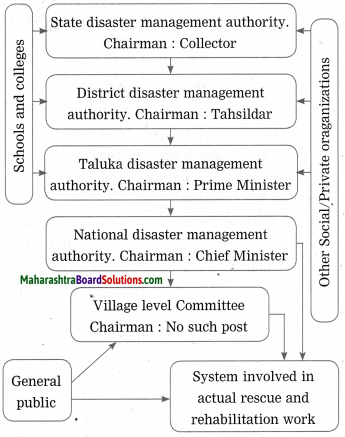
Answer:
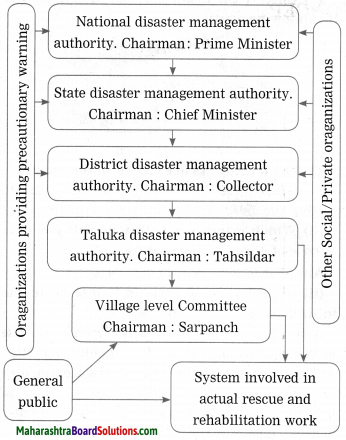
![]()
Projects:
Project 1.
Can you tell? ( Textbook page no. 118)
Whether there had been mock drill by fire fighters under the disaster management scheme in your school? Which techniques did you see during the drill?
Project 2.
Try this: (Textbook page no. 115)
Which factors will you consider while designing the pre-disaster management plan for your school/home? Prepare a survey report with the help of your teacher.
Project 3.
Get information:
(1) Visit the district collector or Taluka Tehasildar office and collect the information about disaster management. (Textbook page no. 115)
(2) Meet the medical officer/doctor from your village and collect information about providing the first aid. (Textbook page no. 118)
Project 4.
Internet is my friend:
(1) Search for the video clips of disasters. Discuss in your class about effects of disasters and remedies over it. (Textbook page no. 110)
(2) Find out more about the activities of international organizations that work for disaster management.
(Textbook page no. 116)
1. United Nations Disaster Relief Organization.
2. United Nations Centre for Human Settlements.
3. Asian Disaster Reduction Centre.
4. Asian Disaster Preparedness Centre.
5. World Health Organization.
6. United Nations Educational, Scientific and Cultural Organization.
Maharashtra State Board Class 10 Science Solutions
- Heredity and Evolution Class 10 Science Solutions
- Life Processes in Living Organisms Part – 1 Class 10 Science Solutions
- Life Processes in Living Organisms Part – 2 Class 10 Science Solutions
- Environmental management Class 10 Science Solutions
- Towards Green Energy Class 10 Science Solutions
- Animal Classification Class 10 Science Solutions
- Introduction to Microbiology Class 10 Science Solutions
- Cell Biology and Biotechnology Class 10 Science Solutions
- Social health Class 10 Science Solutions
- Disaster Management Class 10 Science Solutions